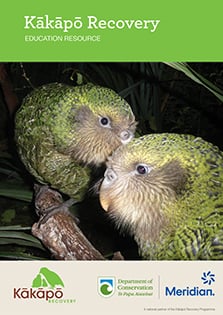This resource has been developed by our partners Meridian Energy.
This resource introduces students to:
- kākāpō ecology: where they live, what they eat, their adaptations, and how they stay alive
- kākāpō challenges: kākāpō threats and how people contribute to these
- kākāpō conservation: the role of people in protecting kākāpō.
Download the resource
Kākāpō Recovery education resource (PDF, 2,693K)
Kākāpō infographic
This infographic explains what a kākāpō is, why they are so vulnerable and how people are working together to help them survive.
Kākāpō infographic (PDF, 495K)
Learning outcomes
Using this resource, students can:
- build knowledge and understanding of kākāpō
- raise awareness of the current situation for kākāpō
- understand how people are involved in kākāpō recovery
- contribute to a positive future for kākāpō.
Curriculum links
Level 1-4 Science
Living World: Ecology
- Recognise that living things are suited to their particular habitats.
Living World: Life processes
- Recognise that living things are suited to their particular habitats.
Nature of Science: Investigating in science
- Ask questions, find evidence, explore simple models and carry out investigations to develop simple explanations.
Science capabilities:
- Gather and interpret data
- Use evidence
- Interpret representations
- Engage with science
Level 1-4 Social science
- Understand how people make decisions about access to and use of resources
- Understand how formal and informal groups make decisions that influence communities
Level 1-4 Mathematics and statistics
- Statistical Investigation: Conduct investigations using the statistical enquiry cycle: gathering, sorting, and displaying multivariate category and whole-number data and simple time-series data to answer questions.
- Identifying patterns and trends in context within and between data sets
Contact
For questions or feedback about these resources, email engagement@doc.govt.nz.

